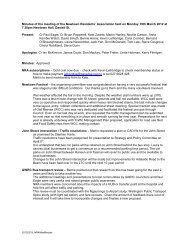Draft Town Belt Management Plan - Wellington City Council
Draft Town Belt Management Plan - Wellington City Council
Draft Town Belt Management Plan - Wellington City Council
You also want an ePaper? Increase the reach of your titles
YUMPU automatically turns print PDFs into web optimized ePapers that Google loves.
eserves lands, the <strong>Council</strong> made a policy decision in 1966 that no further land would be made<br />
available for pre-school education although play centres were permitted to operate from existing<br />
buildings if they did not interfere with sporting activities. Youth activities such as boy scouts and<br />
girl guides were deemed acceptable. In 2008, feelings ran high when controversy flared over<br />
whether or not a crèche was a suitable activity on the <strong>Town</strong> <strong>Belt</strong>. The <strong>Council</strong> eventually decided<br />
against allowing it.<br />
Public works and utility<br />
Another purpose for which <strong>Town</strong> <strong>Belt</strong> land has been used – and often alienated – has been for the<br />
city’s infrastructure both above and below ground. The New Zealand Company’s instructions about<br />
the use of the <strong>Town</strong> <strong>Belt</strong> were not explicit on this aspect of the planned settlement but by the time<br />
the <strong>Town</strong> <strong>Belt</strong> was transferred to the <strong>Council</strong> in 1873, the <strong>Town</strong> <strong>Belt</strong> Deed included ‘public utility’<br />
as well as recreation as a stated purpose.<br />
In any event, infrastructure for the growing town was needed.<br />
Roads were needed to connect the town with the country acres and then to enable suburban growth<br />
as the city expanded. Construction of such connections was authorised in the <strong>Wellington</strong> <strong>City</strong><br />
Reserves Act passed in 1871 120 , and the major roads were completed between the 1870s and 1930s,<br />
aided in some instances by the pick and shovel efforts of relief labour employed in recessionary<br />
times. Several tramlines were also developed in the early 1900s across the <strong>Town</strong> <strong>Belt</strong> to<br />
Wadestown, Kilbirnie, Brooklyn and Island Bay. The public transport network was an important<br />
prerequisite to the city’s expansion in the days before car ownership became the norm.<br />
Connections that had less impact on the <strong>Town</strong> <strong>Belt</strong>’s open space were the tunnels: the Hataitai/<br />
Kilbirnie tram tunnel of 1907 and the Mt Victoria traffic and pedestrian tunnel of 1931. Less wellknown<br />
are the underground service tunnels, such as the drainage and sewerage tunnel built in the<br />
1890s beneath the Mt Victoria ridge (Te Ranga a Hiwi). A brick ventilation tower beside the<br />
Harrier Club building on Alexandra Road still remains today.<br />
In 1879, the holding reservoir in Polhill Gully, which received water from the Karori Reservoir via a<br />
tunnel, was described as the only source of water for the city. The <strong>Town</strong> <strong>Belt</strong>, with its high ground<br />
above the town was an obvious location for water reservoirs in order to achieve good water<br />
pressure.<br />
During the 1880s, some 10<br />
reservoirs, pumping stations or<br />
smaller holding tanks were<br />
constructed at various locations<br />
around the <strong>Town</strong> <strong>Belt</strong>. When, in<br />
the 1990s and 2000s, new or<br />
redeveloped water reservoirs<br />
were constructed on <strong>Town</strong> <strong>Belt</strong> at<br />
Macalister Park, Weld Street and<br />
Mt Albert Road, efforts were<br />
made to meet community<br />
demands to preserve the <strong>Town</strong><br />
<strong>Belt</strong>’s open space and visual<br />
amenity by installing them as far<br />
as possible underground.<br />
The <strong>Town</strong> <strong>Belt</strong>’s hill tops were<br />
also ideal locations for<br />
communications. A signal station<br />
operated on Mt Albert from 1844<br />
to 1866 and a repeater station on<br />
Mt Victoria from 1866 to 1891.<br />
120 <strong>Wellington</strong> <strong>City</strong> Reserves Act 1871<br />
Figure 14: View of Mt Victoria over Oriental Bay, 1965.<br />
The summit area typifies the pressure of use on the <strong>Town</strong> <strong>Belt</strong>’s high<br />
points. Pictured are radio masts and the broadcasting station above<br />
the new road works cut to construct Lookout Road and complete the<br />
ridgetop scenic drive along Alexandra Road. Interestingly, there was<br />
little protest at the time about the visual impact of this roading<br />
development.<br />
(Whites Aviation Collection, Alexander Turnbull Library WA-65323)<br />
<strong>Draft</strong> <strong>Town</strong> <strong>Belt</strong> <strong>Management</strong> <strong>Plan</strong> October 2012<br />
221





